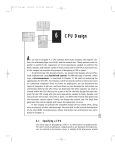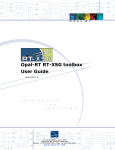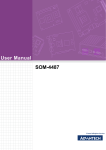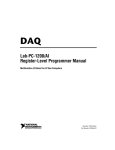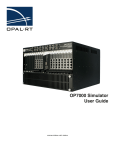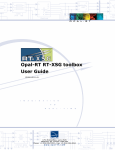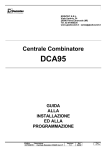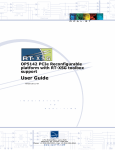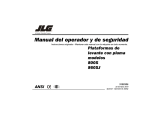Download OP5110 Reconfigurable FPGA Platform and I/O Interface User Manual
Transcript
OP5000 Signal Conditioning & I/O Products for RT-LAB Engineering Simulators OP5110 Reconfigurable FPGA Platform and I/O Interface User Manual Published by Opal-RT Technologies, Inc. 1751 Richardson, suite 2525 Montréal (Québec) Canada H3K 1G6 www.opal-rt.com © 2009 Opal-RT Technologies, Inc. All rights reserved Printed in Canada OP5110_user_manual-C.doc Rev. B User Manual OP5110 Reconfigurable FPGA Platform and I/O Interface 1 TABLE OF CONTENTS 1 Table of Contents ..................................................................................................................... 1 2 Introduction............................................................................................................................... 2 3 4 2.1 About the OP5110 Devices............................................................................................... 2 2.2 Unpacking ......................................................................................................................... 2 2.3 Optional Equipment........................................................................................................... 3 Installation and Configuration................................................................................................... 3 3.1 Hardware Installation ........................................................................................................ 3 3.2 Device Configuration......................................................................................................... 3 Device Overview ...................................................................................................................... 4 4.1 Device Description ............................................................................................................ 4 4.2 Functionality ...................................................................................................................... 4 4.2.1 Static digital input/output (SDIO) ............................................................................... 4 4.2.2 Time-stamped digital input/output (TDIO).................................................................. 4 4.2.3 Parallel interface to D/A and A/D modules ................................................................ 5 4.2.4 Reference pulse generation module (RPG) .............................................................. 5 4.2.5 SignalWire interface................................................................................................... 5 4.3 Functionality Matrix ........................................................................................................... 6 4.3.1 5 Verifying the firmware version on your card .............................................................. 6 Signal Connections .................................................................................................................. 8 5.1 Internal 40-pin I/O connectors........................................................................................... 8 5.2 External 68-pin I/O connectors ....................................................................................... 12 5.3 Internal SignalWire connectors ....................................................................................... 13 5.4 External SignalWire connectors...................................................................................... 13 5.5 Synchronization connectors ............................................................................................ 14 Appendix A – Specifications .......................................................................................................... 15 Appendix B – Example Wiring: RT-LAB WANDA.......................................................................... 16 Appendix C – Ports identification................................................................................................... 17 Appendix D – Block Diagram......................................................................................................... 18 Appendix E – OP5110 PCI Installation Guide ............................................................................... 19 Page 1 User Manual OP5110 Reconfigurable FPGA Platform and I/O Interface 2 INTRODUCTION 2.1 ABOUT THE OP5110 DEVICES The OP5110-series devices are multifunction digital input/output cards that feature a programmable FPGA chip. Currently, this includes the OP5110-1 and OP5110-2 cards. For most applications, the FPGA chip will have been programmed with dedicated code enabling the features needed for your application. Should these requirements ever change, please contact Opal-RT to see if a programming change could better suit your redefined application. Figure 1: OP5110 Reconfigurable FPGA Platform and I/O Interface 2.2 UNPACKING The OP5110 Reconfigurable FPGA Platform and I/O Interface card is usually not installed in your Engineering Simulator. As the card is usually shipped separately, your OP5110 device should be in an antistatic package to prevent an electrostatic discharge to the device. An electrostatic discharge can damage several components on the device. To avoid such damage, be sure to follow these important guidelines: • Ground yourself via a grounding strap or by holding a grounded, metallic object. • Touch the antistatic package to a metal part of your computer chassis before removing the device from the package. • Remove the device from the package and inspect the device for loose components or any sign of damage. If the device appears damaged in any way, please notify Opal-RT Technologies. DO NOT install a damaged device in your computer. • Never touch the exposed pins of connectors. Page 2 User Manual OP5110 Reconfigurable FPGA Platform and I/O Interface • When not in use, store your OP5110 device in the antistatic envelope. 2.3 OPTIONAL EQUIPMENT The OP5100-series cards are designed for use with other OP5000 signal conditioning and interfacing modules. Although stand-alone use is supported, in this manual we assume that the card will be used in an RT-LAB Engineering Simulator. Typically, this card is used in conjunction with either some OP592x backplane adaptor modules or a SignalWire connection to the OP5912 OPXI Backplane for Type A and B Carriers. For more information on these components, please refer to their respective manuals. 3 INSTALLATION AND CONFIGURATION 3.1 HARDWARE INSTALLATION If you need to install the OP5110 card yourself you will need a Phillips #2 screwdriver. After disconnecting all power cables from the computer chassis and opening the case of your system (referred to as the target), you will need to find a free PCI slot. These are usually located at the back or bottom of the PC chassis and feature a slot of multiple connectors in a rectangular connector of about 1cm by 15 cm. Make sure that there is enough clearance on each side of the OP5110 card once inserted in order for the cable connections to be free of sharp bends and clear of sharp metal parts which could damage the connections. Insert the card by first removing the blank faceplate aligned with the PCI slot on the computer's chassis. Secure the card in its slot by re-using the mounting screw of the faceplate. This should require firm, but not excessive pressure. See appendix E for detailed instructions. 3.2 DEVICE CONFIGURATION If your system has multiple OP5110-series cards, each of these must possess a unique board index. Possible board indices range from 12 to 15, with the default board index of 15 being the master card for all other cards in the system most of the time. It is not always the case as the board with index 15 can also be in slave mode. Refer to your system configuration and to your bitstream selection. The board index is set using the JP8 jumper terminal. By default, the jumpers should be installed on the card so that its board index is set to 15. This is the required setting when there is only one card in the target computer. Other JP8 configurations are used when several cards are installed in the same target and when a master/slave configuration is needed. Index 15 Index 14 Index 13 Index 12 Page 3 User Manual OP5110 Reconfigurable FPGA Platform and I/O Interface For the clock signal to be propagated from the master card to the other cards, you must connect the clock synchronization cable, as specified in section 5.5. 4 DEVICE OVERVIEW 4.1 DEVICE DESCRIPTION The OP5110 card is based around a Xilinx FPGA chip that performs the computational and input/output functionalities. This chip controls 128 digital lines, which can be used, depending on the firmware used, in various configurations. The card's firmware is a special piece of software that resides onboard and is typically not directly available to the user. This program controls the low-level hardware in order to perform specific task. Each firmware branch supports a different set of input/output configurations. Each configuration is, in turn, a set of base functions using one or more of the FPGA's digital lines. The next section (4.2) defines the base functionalities, or functional building blocks available. The upcoming Functionality Matrix section shows the configurations (combinations of base functionalities) supported by each firmware branch. 4.2 FUNCTIONALITY The functionalities described below are the basic interactions that the card hardware can have with the systems connected to it. In many cases, higher-level applications can be built on top of these low-level functionalities. For each low-level functionality described below, we give a few of the applications that are supported through the RT-LAB software. 4.2.1 STATIC DIGITAL INPUT/OUTPUT (SDIO) The static digital input or output functionality allows you to set or get the state of one of the digital signal lines to one of two discrete values. These values are either a logical "off" level of 0 volts or a logical "on" level of 3.3 volts relative to the card's ground. These signal lines are named "static" because their state can only be set or read once for every cycle (or computation step) of the simulation. Typical applications of static digital input/output are: • Switch monitoring/simulation • Relay driver • Logical control signals Note that for the static digital input/outputs, the signals are in groups of 8 lines. A letter ranging from A to P identifies each group. This is the notation used in the RT-LAB blocks that use this functionality. 4.2.2 TIME-STAMPED DIGITAL INPUT/OUTPUT (TDIO) Time-stamped digital inputs and outputs offer the same functionality as the static digital inputs and outputs but, with the added possibility that the signal lines can be toggled or read multiple times and with precise timing during one of the simulation's cycle. This enables you to detect or generate discrete events with precise timing (down to 10ns resolution). Page 4 User Manual OP5110 Reconfigurable FPGA Platform and I/O Interface Furthermore, with a higher-level algorithm such as the ones implemented in the RT-LAB and RTEVENTS block sets, it is possible to use the time-stamped ports for: • Frequency (square-wave) signal generation/detection • PWM signal generation/detection • Quadrature encoder simulation/detection • Arbitrary digital pulse-train generation and detection As for the static signals, the time-stamped digital signals are in groups of 8 lines. A letter ranging from A to P identifies each group. This is the notation used in the RT-LAB blocks that use this functionality. 4.2.3 PARALLEL INTERFACE TO D/A AND A/D MODULES In conjunction with an OP5220 Type B I/O Module Carrier (passive), it is possible to use a group of 32 digital signal lines to control and access 16 analog outputs (OP5330 A/D Converter and Signal Conditioning Module) or 16 analog inputs (OP5340 D/A Converter and Signal Conditioning Module). The access to these analog inputs or outputs is controlled through the corresponding blocks in the RT-LAB block set and allow the following: 4.2.4 • Sensor simulation/reading (temperature, pressure, force, displacement, and much more) • Actuator control • Arbitrary waveform playback/detection REFERENCE PULSE GENERATION MODULE (RPG) The reference pulse generation module allows for the generation of digital events synchronized on a position (angular) reference. The typical use of this module is to generate engine events, such as spark and fuel injection based on an engine's angular position. Note that this is much like the time-stamped digital output functionality, with the generation of events being position-based rather than time-based. The engine can be simulated in the RPG module. The simulated engine RPM must be given periodically to the RPG core, using its Simulink block. This RPM is used to generate the position pulse train (with 0.1 or 0.01 degrees of precision) and the synchronous events will be generated according to the event specifications given at initialization time. The RPG module can also be used to generate synchronous events for a real engine. For this, the engine position, CAM and index pulse trains are fed to the RPG module as 0-5 volts signals. Synchronous events will be generated from this external position reference according to the event specifications given at initialization time. The RPG module can perform up sampling of the reference signal, which allows the generation of events within 0.1 or 0.01 degrees of precision with a 1-degree period for the position signal given as input. 4.2.5 SIGNALWIRE INTERFACE SignalWire is a high-speed (625 Mbps) serial data link developed by Opal-RT as a means to link multiple I/O devices together. Page 5 User Manual OP5110 Reconfigurable FPGA Platform and I/O Interface When used in conjunction with an OP5130 Type B I/O Module Carrier (active), it is possible to use a group of 32 digital signal lines to control and access 16 analog outputs (OP5330 A/D Converter and Signal Conditioning Module) or 16 analog inputs (OP5340 D/A Converter and Signal Conditioning Module). Moreover, many application-specific I/O devices are being developed by Opal-RT Technologies which use a SignalWire link to interface with RT-LAB Engineering Simulators. The access to all these field I/O devices is controlled through the corresponding blocks in the RTLAB block set and use of the SignalWire serial link is transparent to the user. 4.3 FUNCTIONALITY MATRIX The table that follows shows the various possible configurations for each firmware program available for the OP5110-series cards. Each card shipped is identified with the firmware branch and revision used for its programming. Please use the table to understand the possible combinations of features available to you. Firmware JP3 (IJKL) JP4 (MNOP) JP5 (ABCD) JP6 (EFGH) SignalWire 1C-2 - - ESPG ESPG - 0x26 0026-27 16 D/A 16 A/D 16 D/A 16 A/D Internal 0x30 30-29 16 A/D 16 A/D 32 TSDIN 32 TSDOUT Internal 0x35 35-21 16 D/A 16 A/D 16 TSDIN / 16 TSDOUT 16 TSDIN / 16 TSDOUT Internal 0x36 36-35 SPI - 16 TSDIN / 16 TSDOUT - Internal 0x39 39-20 16 D/A 16 D/A 16 TSDIN 16 TSDOUT 16 TSDIN / 16 TSDOUT Internal Device ID (S17-0016PCI prefix) 0x1C Table 1: Firmware configuration matrix for OP5110-series cards Note that the last digit of the firmware name is the revision and might be more recent on the card you received. The configurations should nonetheless be identical if the other numbers match those of your card. Note also that the firmware list provided in Table 1 is not exhaustive. Only the most commonly-used and most up-to-date versions are listed. 4.3.1 VERIFYING THE FIRMWARE VERSION ON YOUR CARD The PCI vendor ID for the OP5110 is EDDD. When listing all of the PCI devices in your system, look for this vendor identification to locate the information referring to the OP5110 card. The PCI device ID will refer to the firmware branch (in this case 1A) and the revision displayed will be the revision of the firmware (8 here). All numbers are in hexadecimal representation. From the QNX command line, using the "pci -v | less" will give a listing of all the PCI devices found in you computer system. For Linux, the equivalent command is "lspci –n –v | less". Under QNX (partial listing shown): Page 6 User Manual OP5110 Reconfigurable FPGA Platform and I/O Interface # pci –v | less Class Vendor ID Device ID PCI index Revision ID Interrupt line = = = = = = System Peripherals (Unknown) edddh, Unknown 1ah, Unknown Unknown 0h 8h 11 Under Linux (partial listing shown): # lspci –v –n | less 02:06.0 Class 0880: eddd:001A (rev 08) Flags: bus master, medium devsel, latency 0, IRQ 17 Memory at d0240000 (32-bit, non-prefetchable) [size=256K] Page 7 User Manual OP5110 Reconfigurable FPGA Platform and I/O Interface 5 SIGNAL CONNECTIONS 5.1 INTERNAL 40-PIN I/O CONNECTORS Hardware Pin# Name 1 2 3 4 5 6 7 8 9 10 11 12 13 14 15 16 17 18 19 20 21 22 23 24 25 26 27 28 29 30 31 32 33 34 35 36 37 38 39 40 IO0 GND IO1 IO2 IO3 IO4 IO5 IO6 IO7 IO8 IO9 IO10 IO11 IO12 IO13 IO14 IO15 IO16 GND IO17 GND IO18 GND IO19 GND IO20 IO21 IO22 GND IO23 IO24 IO25 IO26 IO27 IO28 IO29 IO30 IO31 GND Static and TimeStamped DIO A0 GND A1 A2 A3 A4 A5 A6 A7 B0 B1 B2 B3 B4 B5 B6 B7 C0 GND C1 GND C2 GND C3 GND C4 C5 C6 GND C7 D0 D1 D2 D3 D4 D5 D6 D7 GND Functionality Mapping DAC ADC Not Available Not Available - Table 2: Pin Assignment for JP5 Connector Page 8 RPG (IN / OUT) A0 / Position IN GND A1 / A2 / Index IN A3 / A4 / CAM IN A5 / A6 / A7 / B0 / B0 B1 / B1 B2 / B2 B3 / B3 B4 / B4 B5 / B5 B6 / B6 B7 / B7 C0 / RPG_00 GND C1 / RPG_01 GND C2 / RPG_02 GND C3 / RPG_03 GND C4 / RPG_04 C5 / RPG_05 C6 / RPG_06 GND C7 / RPG_07 D0 / RPG_08 D1 / RPG_09 D2 / RPG_10 D3 / RPG_11 D4 / RPG_12 D5 / RPG_13 D6 / RPG_14 D7 / RPG_15 GND User Manual OP5110 Reconfigurable FPGA Platform and I/O Interface Hardware Pin# Name 1 2 3 4 5 6 7 8 9 10 11 12 13 14 15 16 17 18 19 20 21 22 23 24 25 26 27 28 29 30 31 32 33 34 35 36 37 38 39 40 IO32 GND IO33 IO34 IO35 IO36 IO37 IO38 IO39 IO40 IO41 IO42 IO43 IO44 IO45 IO46 IO47 IO48 GND IO49 GND IO50 GND IO51 GND IO52 IO53 IO54 GND IO55 IO56 IO57 IO58 IO59 IO60 IO61 IO62 IO63 GND Static and TimeStamped DIO E0 GND E1 E2 E3 E4 E5 E6 E7 F0 F1 F2 F3 F4 F5 F6 F7 G0 GND G1 GND G2 GND G3 GND G4 G5 G6 GND G7 H0 H1 H2 H3 H4 H5 H6 H7 GND Functionality Mapping DAC ADC Not Available Not Available - Table 3: Pin Assignment for JP6 Connector Page 9 RPG E0 / E0 GND E1 / E1 E2 / E2 E3 / E3 E4 / E4 E5 / E5 E6 / E6 E7 / E7 F0 / C0 F1 / C1 F2 / C2 F3 / C3 F4 / C4 F5 / C5 F6 / C6 F7 / C7 G0 / D0 GND G1 / D1 GND G2 / D2 GND G3 / D3 GND G4 / D4 G5 / D5 G6 / D6 GND G7 / D7 - / CAM OUT - / Index OUT - / Position OUT GND User Manual OP5110 Reconfigurable FPGA Platform and I/O Interface Hardware Pin# Name 1 2 3 4 5 6 7 8 9 10 11 12 13 14 15 16 17 18 19 20 21 22 23 24 25 26 27 28 29 30 31 32 33 34 35 36 37 38 39 40 IO64 GND IO65 IO66 IO67 IO68 IO69 IO70 IO71 IO72 IO73 IO74 IO75 IO76 IO77 IO78 IO79 IO80 GND IO81 GND IO82 GND IO83 GND IO84 IO85 IO86 GND IO87 IO88 IO89 IO90 IO91 IO92 IO93 IO94 IO95 GND Static and TimeStamped DIO I0 GND I1 I2 I3 I4 I5 I6 I7 J0 J1 J2 J3 J4 J5 J6 J7 K0 GND K1 GND K2 GND K3 GND K4 K5 K6 GND K7 L0 L1 L2 L3 L4 L5 L6 L7 GND Functionality Mapping DAC (A) ADC (A) dac_LDAC0 GND dac_SDI0 dac_SDI1 SCL dac_SDI2 dac_LDAC1 SDA dac_LDAC2 dac_LDAC3 dac_SDI3 adj_SDI1 adj_SDI0 adj_SDI3 adj_SDI2 adj_CLK adj_nCS dac_MSB GND dac_nRST GND GND dac_nCS GND dac_CLK dac_LDAC4 GND dac_SDI4 dac_SDI5 dac_SDI6 dac_LDAC5 dac_LDAC6 dac_LDAC7 dac_SDI7 GND adc_CONV0 GND SCL adc_CONV2 adc_CONV1 SDA adc_CONV3 adc_SDA0 adc_SDB0 adc_SDB1 adc_SDA1 adc_SDA2 adc_SDB2 adc_SDB3 adc_SDA3 adc_A0 GND adc_CONV4 GND adc_CONV5 GND adc_nCS GND adc_CLK adc_CONV6 adc_CONV7 GND adc_SDA4 adc_SDB4 adc_SDB5 adc_SDA5 adc_SDA6 adc_SDB6 adc_SDB7 adc_SDA7 GND Table 4: Pin Assignment for JP3 Connector Page 10 RPG Not Available - User Manual OP5110 Reconfigurable FPGA Platform and I/O Interface Hardware Pin# Name 1 2 3 4 5 6 7 8 9 10 11 12 13 14 15 16 17 18 19 20 21 22 23 24 25 26 27 28 29 30 31 32 33 34 35 36 37 38 39 40 IO96 GND IO97 IO98 IO99 IO100 IO101 IO102 IO103 IO104 IO105 IO106 IO107 IO108 IO109 IO110 IO111 IO112 GND IO113 GND IO114 GND IO115 GND IO116 IO117 IO118 GND IO119 IO120 IO121 IO122 IO123 IO124 IO125 IO126 IO127 GND Static and TimeStamped DIO M0 GND M1 M2 M3 M4 M5 M6 M7 N0 N1 N2 N3 N4 N5 N6 N7 O0 GND O1 GND O2 GND O3 GND O4 O5 O6 GND O7 P0 P1 P2 P3 P4 P5 P6 P7 GND Functionality Mapping DAC (B) ADC (B) dac_LDAC0 GND dac_SDI0 dac_SDI1 SCL dac_SDI2 dac_LDAC1 SDA dac_LDAC2 dac_LDAC3 dac_SDI3 adj_SDI1 adj_SDI0 adj_SDI3 adj_SDI2 adj_CLK adj_nCS dac_MSB GND dac_nRST GND GND dac_nCS GND dac_CLK dac_LDAC4 GND dac_SDI4 dac_SDI5 dac_SDI6 dac_LDAC5 dac_LDAC6 dac_LDAC7 dac_SDI7 GND adc_CONV0 GND SCL adc_CONV2 adc_CONV1 SDA adc_CONV3 adc_SDA0 adc_SDB0 adc_SDB1 adc_SDA1 adc_SDA2 adc_SDB2 adc_SDB3 adc_SDA3 adc_A0 GND adc_CONV4 GND adc_CONV5 GND adc_nCS GND adc_CLK adc_CONV6 adc_CONV7 GND adc_SDA4 adc_SDB4 adc_SDB5 adc_SDA5 adc_SDA6 adc_SDB6 adc_SDB7 adc_SDA7 GND Table 5: Pin Assignment for JP4 Connector Page 11 RPG Not Available - User Manual OP5110 Reconfigurable FPGA Platform and I/O Interface 5.2 EXTERNAL 68-PIN I/O CONNECTORS The JP2 high-density external connector can be used instead of the internal IO connectors JP3JP6; It gives a more direct access to digital IO lines from the outside of the computer enclosure. This is not supported in all firmware releases. Please contact Opal-RT Technologies support ([email protected]) for more information. The "left" and "right" side notations are relative to the connector as viewed from outside the computer case with the top where the securing screw is mounted. Pin # 1 2 3 4 5 6 7 8 9 10 11 12 13 14 15 16 17 18 19 20 21 22 23 24 25 26 27 28 29 30 31 32 33 34 35 36 37 38 39 40 41 42 Left-side 68-pin connector Name Static and TimeStamped DIO GND GND GND GND GND GND GND GND GND GND GND GND GND GND GND GND GND GND GND GND GND GND GND GND GND GND GND GND GND GND GND GND GND GND GND GND GND GND GND GND GND GND GND GND GND GND GND GND GND GND GND GND +5V +5V IO68 I4 IO70 I6 IO72 J0 IO74 J2 IO76 J4 IO78 J6 IO40 F0 IO41 F1 IO42 F2 IO43 F3 IO44 F4 IO45 F5 IO46 F6 IO47 F7 Right-side 68-pin connector Pin Name Static and Time# Stamped DIO 1 GND GND 2 GND GND 3 GND GND 4 GND GND 5 GND GND 6 GND GND 7 GND GND 8 GND GND 9 GND GND 10 GND GND 11 GND GND 12 GND GND 13 GND GND 14 GND GND 15 GND GND 16 GND GND 17 GND GND 18 GND GND 19 GND GND 20 GND GND 21 GND GND 22 GND GND 23 GND GND 24 GND GND 25 GND GND 26 GND GND 27 +5V 28 +5V 29 IO28 D4 30 IO30 D6 31 IO32 E0 32 IO34 E2 33 IO36 E4 34 IO38 E6 35 IO00 A0 36 IO01 A1 37 IO02 A2 38 IO03 A3 39 IO04 A4 40 IO05 A5 41 IO06 A6 42 IO07 A7 Page 12 User Manual OP5110 Reconfigurable FPGA Platform and I/O Interface 43 44 45 46 47 48 49 50 51 52 53 54 55 56 57 58 59 60 61 62 63 64 65 66 67 68 IO48 IO49 IO50 IO51 IO52 IO53 IO54 IO55 IO56 IO57 IO58 IO59 IO60 IO61 IO62 IO63 IO64 IO65 IO66 IO67 IO69 IO71 IO73 IO75 IO77 IO79 G0 G1 G2 G3 G4 G5 G6 G7 H0 H1 H2 H3 H4 H5 H6 H7 I0 I1 I2 I3 I5 I7 J1 J3 J5 J7 43 44 45 46 47 48 49 50 51 52 53 54 55 56 57 58 59 60 61 62 63 64 65 66 67 68 IO08 IO09 IO10 IO11 IO12 IO13 IO14 IO15 IO16 IO17 IO18 IO19 IO20 IO21 IO22 IO23 IO24 IO25 IO26 IO27 IO29 IO31 IO33 IO35 IO37 IO39 B0 B1 B2 B3 B4 B5 B6 B7 C0 C1 C2 C3 C4 C5 C6 C7 D0 D1 D2 D3 D5 D7 E1 E3 E5 E7 Table 6: Pin assignment for the JP2 external dual 68-pin connector 5.3 INTERNAL SIGNALWIRE CONNECTORS The internal SignalWire connections are typically used to communicate with an OP5130 FPGAbased Type B I/O Module Carrier. The recommended connection is through shielded twisted-pair cables. Pin# 1 2 3 4 5 6 7 8 JP13 SignalWire Connector Name GND RX RX + RX Shield TX Shield TX TX + GND Table 7: Pin assignment for the JP13 SignalWire connector 5.4 EXTERNAL SIGNALWIRE CONNECTORS The external SignalWire connectors are not currently supported in any of the available firmware branches. Page 13 User Manual OP5110 Reconfigurable FPGA Platform and I/O Interface 5.5 SYNCHRONIZATION CONNECTORS The synchronization connector JP7 is a 34-pin IDC header connector, which allows the propagation of the clock signal from the master card to the slave cards. In the current generation of cards, only signal RTSI0 is used. The RTSI0 line is configured as an output for cards in master mode (index 15). Any other board index will put the card in slave mode and RTSI0 becomes an input. JP7 Synchronization Connector Pin# Name 19 GND 20 RTSI0 21 GND 22 RTSI1 23 GND 24 RTSI2 25 GND 26 RTSI3 27 GND Table 9: Pin assignment for the JP7 synchronization connector Alternatively, the JP12 connector can also be used to input or output the synchronization signal. In order to activate the RTSI0 signal on the JP12 connector, the "Auto Detect" pin must be shorted to GND. JP12 Synchronization Connector Pin# Name 3 Auto Detect 4 RTSI0 5 +5V 6 GND Table 10: Pin assignment for the JP12 synchronization connector Page 14 User Manual OP5110 Reconfigurable FPGA Platform and I/O Interface APPENDIX A – SPECIFICATIONS Digital I/O Number of channels ………………………………………………………… Compatibility ………………………………………………………………… Power-on state ……………………………………………………………… Levels Level Minimum Maximum Input low 0.0v 0.8v Input high 2.0v 5.5v Output low – 12mA (sink) 0.0v 0.4v Output high – 12mA (source) 2.4v 3.3v 128 input/output TTL High impedance For additional signal conditioning and protection, see OP531x specifications. FPGA Device ……………………………………………………………………… I/O package ………………………………………………………………… Available RAM ……………………………………………………………… Clock ………………………………………………………………………… Platform options …………………………………………………………… Logic slices ………………………………………………………………… Equivalent logic cells ……………………………………………………… Available I/O lines ………………………………………………………… Xilinx Virtex II Pro 625FF 16 KB (ext. to 2MB) 62.5, 100MHz XC2V1000 5,120 11,500 396 PCI …………………………………………………………………………… 32-bit, 33MHz, 1Gbps 64-bit, 66MHz, 4Gbps Interrupt or DMA Bus Data transfers ……………………………………………………………… I/O connectors Internal DIO …………………………………………… Internal SignalWire …………………………………… External DIO …………………………………………… External SignalWire …………………………………… 4 x 40-way header AMP 120613-1 2 x Molex 35362-0810 1 x Molex 74337-0011 2 x Lumberg 2301F90V203 Environmental Operating temperature …………………………………………… Storage temperature ……………………………………………… Relative humidity …………………………………………………… Maximum altitude ………………………………………………… Page 15 0 - 70°C -55 - 105°C 10 - 90%, non-condensing 2,000 meters User Manual OP5110 Reconfigurable FPGA Platform and I/O Interface APPENDIX B – EXAMPLE WIRING: RT-LAB WANDA Below is an example of the OP5110 card being used in an RT-LAB Engineering Simulator. In this configuration, it allows for 16 digital inputs, 16 digital outputs, all time-stamped (JP5) as well as 16 DAC (JP3) and 16 ADC (JP4) channels connected in parallel. The SignalWire port is also used to retrieve another set of 16 DAC channels from another FPGAbased card: the OP5130. The RTSI port allows synchronization between both FPGA cards (OP5110 and OP5130). Figure 2: Example wiring of an OP5110 using an RT-LAB Wanda Page 16 User Manual OP5110 Reconfigurable FPGA Platform and I/O Interface APPENDIX C – PORTS IDENTIFICATION Figure 3: Ports identification of the OP5110. Page 17 User Manual OP5110 Reconfigurable FPGA Platform and I/O Interface APPENDIX D – BLOCK DIAGRAM Figure 4: OP5110 Block diagram Page 18 User Manual OP5110 Reconfigurable FPGA Platform and I/O Interface APPENDIX E – OP5110 PCI INSTALLATION GUIDE HOW TO INSTALL YOUR FPGA PCI (OP5110 : 126-0158 OR 126-0107) Caution: this product is sensitive to static electricity. Before you start, be sure the system is not connected to power line. Test Drive : HIL: Installation: • Remove the panel (TestDrive : back panel, HIL : top panel) TestDrive : • Connect the gray cable to the JP13 connector of the OP5110. • Secure the bracket, by using the available screw. • HIL : • You can now put back the back panel. If necessary: - Connect the flat cable to JP3, JP4, JP5, JP6 - Installed the signal wire cable to JP13 connectors of the OP5110. Install the Synchronisation cable to JP12 connectors of the OP5110. Note: The cable are already inside your system. - • Secure the bracket, by using the available screw. • You can now put back the top panel. Page 19 JP6 Push the PCI card into the empty slot, so that it is fully seated in the slot. JP5 • JP4 Carrefully insert the PCI card into the empty slot (the one without a bracket) of the target. JP13 JP3 • JP12





















